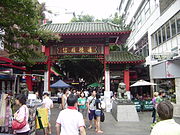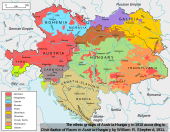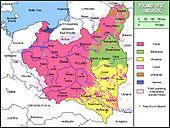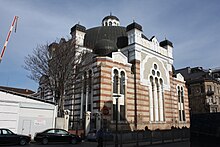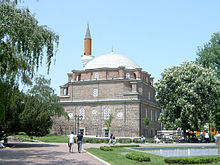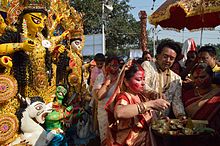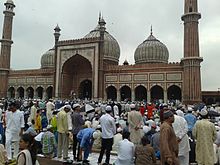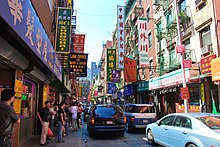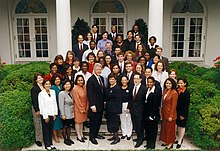From Wikipedia, the free encyclopedia
Multiculturalism is a term with a range of meanings in the contexts of
sociology,
political philosophy, and in colloquial use. In sociology and everyday usage, it is a synonym for "
ethnic pluralism" with the two terms often used interchangeably, for example a
cultural pluralism
in which various ethnic groups collaborate and enter into a dialogue
with one another without having to sacrifice their particular
identities. It can describe a mixed ethnic community area where multiple
cultural traditions exist, or a single country within which they do.
Groups associated with an aboriginal ethnic group and foreigner ethnic
groups are often the focus.
In reference to sociology, multiculturalism is the end state of
either a natural or artificial process (e.g. legally controlled
immigration) and occurs on either a large national scale or a smaller
scale within a nation's communities. On a smaller scale this can occur
artificially when a jurisdiction is created or expanded by amalgamating
areas with two or more different cultures (e.g.
French Canada and
English Canada).
On a large scale, it can occur as a result of either legal or illegal
immigration to and from different jurisdictions around the world.
Multiculturalism as a political philosophy involves ideologies and policies which vary widely,
[1] ranging from the advocacy of equal respect to the various cultures in a society, to policies of promoting the maintenance of
cultural diversity, to policies in which people of various
ethnic and
religious groups are addressed by the authorities as defined by the group to which they belong.
[2][3]
Multiculturalism that promotes maintaining the distinctiveness of
multiple cultures is often contrasted to other settlement policies such
as
social integration,
cultural assimilation and
racial segregation. Multiculturalism has been described as a "
salad bowl" and "
cultural mosaic"
[4] in contrast to a
melting pot.
Two different and seemingly inconsistent strategies have developed
through different government policies and strategies. The first focuses
on interaction and communication between different cultures; this
approach is also often known as
interculturalism. The second centers on diversity and cultural uniqueness which can sometimes result in
intercultural competition over jobs among other things and may lead to
ethnic conflict.
[5][6]
Controversy surrounding the issue of cultural isolation includes the
ghettoization of a culture within a nation and the protection of the
cultural attributes of an area or nation. Proponents of government
policies often claim that artificial, government guided protections also
contribute to global cultural diversity.
[7][8]
The second approach to multiculturalist policy making maintains that
they avoid presenting any specific ethnic, religious, or cultural
community
values as central.
[9]
Prevalence
In the
political philosophy
of multiculturalism, ideas are focused on the ways in which societies
are either believed to, or should, respond to cultural and religious
differences. It is often associated with "identity politics", "the
politics of difference", and "the politics of recognition". It is also a
matter of economic interests and
political power.
(Stanford Encyclopedia of Philosophy). In more recent times political
multiculturalist ideologies have been expanding in their use to include
and define disadvantaged groups such as
African Americans,
LGBT, with arguments often focusing on ethnic and religious minorities, minority nations,
indigenous peoples
and even the disabled. It is within this context which the term is most
commonly understood and the broadness and scope of the definition, as
well as its practical use, has been the subject of serious debate.
Most debates over multiculturalism center around whether or not
multiculturalism is the appropriate way to deal with diversity and
immigrant integration. The arguments regarding the perceived rights to a
multicultural education include the proposition that it acts as a way
to demand recognition of aspects of a group's culture osubordination and
its entire experience.
The term multiculturalism is most often used in reference to Western
nation-states, which had seemingly achieved a de facto single national identity during the 18th and/or 19th centuries.
[10] Multiculturalism has been official policy in several
Western nations since the 1970s, for reasons that varied from country to country,
[11][12][13] including the fact that many of the great cities of the Western world are increasingly made of a mosaic of cultures.
[14]
The
Canadian government has often been described as the instigator of multicultural ideology because of its public emphasis on the
social importance of immigration.
[15][16] The Canadian
Royal Commission on Bilingualism and Biculturalism is often referred to as the origins of modern political awareness of multiculturalism.
[17]
In the Western English-speaking countries, multiculturalism as an
official national policy started in Canada in 1971, followed by
Australia in 1973 where it is maintained today.
[18][19][20][21] It was quickly adopted as official policy by most member-states of the
European Union. Recently, right-of-center governments in several European states – notably the
Netherlands and
Denmark – have reversed the national policy and returned to an official monoculturalism.
[22][unreliable source?]
A similar reversal is the subject of debate in the United Kingdom,
among others, due to evidence of incipient segregation and anxieties
over "home-grown"
terrorism.
[23]
Several heads-of-state or heads-of-government have expressed doubts
about the success of multicultural policies: The United Kingdom's ex-
Prime Minister David Cameron,
German Chancellor Angela Merkel,
Australia's ex-prime minister
John Howard,
Spanish ex-prime minister
Jose Maria Aznar and
French ex-president
Nicolas Sarkozy have voiced concerns about the effectiveness of their multicultural policies for integrating immigrants.
[24][25]
Many nation-states in Africa, Asia, and the Americas are culturally diverse, and are 'multicultural' in a
descriptive sense. In some,
communalism
is a major political issue. The policies adopted by these states often
have parallels with multiculturalist policies in the Western world, but
the historical background is different, and the goal may be a
mono-cultural or
mono-ethnic nation-building – for instance in the Malaysian government's attempt to create a 'Malaysian race' by 2020.
[26]
Australia
The next country to adopt an official policy of multiculturalism
after Canada was Australia, a country with similar immigration
situations and similar policies, for example the formation of the
Special Broadcasting Service.
[27] The Australian government retains multiculturalism in policy, and as a defining aspect of Australia today.
[18][19][21][28]
The
White Australia Policy was quietly dismantled after World War II by various changes to
immigration policy, although the official policy of multiculturalism was not formally introduced until 1972.
[29]
The election of John Howard's Liberal-National Coalition government in
1996 was a major watershed for Australian multiculturalism. Howard had
long been a critic of multiculturalism, releasing his
One Australia policy in the late 1980s.
[30] A Practical Reference to Religious Diversity for Operational Police and Emergency Services was a publication of the
Australasian Police Multicultural Advisory Bureau
designed to offer guidance to police and emergency services personnel
on how religious affiliation can affect their contact with the public.
The first edition was published in 1999.
[31][32][33] The first edition covered
Buddhist,
Hindu,
Islamic,
Jewish and
Sikh faiths with participation of representatives of the various religions.
[34] The second edition added Christian, Australian
Aboriginal and
Torres Strait Islander religions and the
Bahá'í Faith to the list of religions was published in 2002.
[35]
Contact between people of different cultures in Australia has been
characterised by tolerance and engagement, but have also occasionally
resulted in conflict and rifts.
[36][37]
Australia's diverse migrant communities have brought with them food,
lifestyle and cultural practices, which have been absorbed into
mainstream Australian culture.
[18][19]
Mauritius
Multiculturalism has been a characteristic feature of the island of
Mauritius.
[38] Mauritian society includes people from many different ethnic and religious groups: Hindu, Muslim and
Indo-Mauritians,
Mauritian Creoles (of African and
Malagasy descent), Buddhist and Roman Catholic
Sino-Mauritians and
Franco-Mauritians (descendants of the original
French colonists).
[39]
Europe
The European Union is facing unprecedented demographic changes (an
ageing population, low birth rates, changing family structures and
migration). According to the European Commission, it is important, both
at EU and national level, to review and adapt existing policies.
Following a public debate, a 2006 EU policy paper identified five key
policy responses to manage demographic change, among them receiving and
integrating migrants into Europe.
[40]
Historically, Europe has always been a mixture of Latin, Slavic,
Germanic, Uralic, Celtic, Hellenic, Illyrian, Thracian and other
cultures influenced by the importation of Jewish, Christian, Muslim and
other belief systems; although the continent was supposedly unified by
the super-position of Imperial Roman Christianity, it is accepted that
geographic and cultural differences continued from antiquity into the
modern age.
[41]
In the 19th century, the ideology of
nationalism transformed the way Europeans thought about the
state.
[41] Existing states were broken up and new ones created; the new
nation-states were founded on the principle that each
nation is entitled to its own
sovereignty
and to engender, protect, and preserve its own unique culture and
history. Unity, under this ideology, is seen as an essential feature of
the nation and the nation-state – unity of descent, unity of culture,
unity of language, and often unity of religion. The nation-state
constitutes a culturally
homogeneous society, although some national movements recognized regional differences.
Where cultural unity was insufficient, it was encouraged and enforced by the state.
[42] The 19th-century nation-states developed an array of policies – the most important was compulsory
primary education in the
national language.
[42]
The language itself was often standardized by a linguistic academy, and
regional languages were ignored or suppressed. Some nation-states
pursued violent policies of
cultural assimilation and even
ethnic cleansing.
[42]
Some European Union countries have introduced policies for "social
cohesion", "integration", and (sometimes) "assimilation". The policies
include:
Other countries have instituted policies which encourage cultural separation.
[45] The concept of "
Cultural exception"
proposed by France in the General Agreement on Tariffs and Trade (GATT)
negotiations in 1993 was an example of a measure aimed at protecting
local cultures.
[46]
Bulgaria
Since its establishment in 7th century
Bulgaria
has hosted many religions, ethnic groups and nations. The capital Sofia
is the only European city that has peacefully functioning, within
walking distance of 300 meters,
[47][48] four
Places of worship of the major religions: Eastern Orthodox (
St Nedelya Church), Islam (
Banya Bashi Mosque), Roman Catholicism (
St Joseph Cathedral), and Orthodox Judaism (
Sofia Synagogue, the third largest synagogue in Europe).
This unique arrangement has been called by historians a "multicultural cliche".
[49] It has also become known as "The Square of Religious Tolerance"
[50][51] and has initiated the construction of a 100-square-meter scale model of the site that is to become a symbol of the capital.
[52][53][54]
Furthermore, unlike some other
Nazi Germany allies or German-occupied countries excluding
Denmark, Bulgaria managed to save its entire 48,000-strong Jewish population during World War II from deportation to
Nazi concentration camps.
[55][56]
According to Dr Marinova-Christidi the main reason for the efforts of
Bulgarian people to save the Bulgarian Jews during WWII is that within
the region they "co-existed for centuries with other religions" – giving
it a unique multicultural and multiethnic history.
[57]
Consequently, within the Balkan region Bulgaria has become an example
for multiculturalism in terms of variety of religions, artistic
creativity
[58] and ethnicity.
[59][60]
Its largest ethnic minorities, Turks and Roma, enjoy wide political
representation. In 1984, following a campaign by the communist regime
for a forcible change of the Islamic names of the Turkish minority,
[61][62][63][64]
an underground organization called «National Liberation Movement of the
Turks in Bulgaria» was formed which headed the Turkish community's
opposition movement. On January 4, 1990 the activists of the movement
registered an organization with the legal name «Movement for Rights and
Freedom» (MRF) (in Bulgarian: Движение за права и свободи: in Turkish:
Hak ve Özgürlükler Hareketi) in the Bulgarian city of Varna. At the
moment of registration it had 33 members, at present, according to the
organization's website, 68,000 members plus 24,000 in the organization's
youth wing
[1].
In 2012 Bulgarian Turks were represented at every level of government:
local, with MRF having mayors in 35 municipalities, at parliamentary
level with MRF having 38 deputies (14% of the votes in Parliamentary
elections for 2009–13)
[65] and at executive level, where there is one Turkish minister,
Vezhdi Rashidov. Twenty-one Roma political organizations were founded between 1997 and 2003 in Bulgaria.
[66]
Germany
In October 2010,
Angela Merkel told a meeting of younger members of her centrist
Christian Democratic Union (CDU) party at
Potsdam, near
Berlin, that attempts to build a multicultural society in
Germany had "utterly failed",
[67] stating: "The concept that we are now living side by side and are happy about it does not work".
[67][68]
She continued to say that immigrants should integrate and adopt
Germany's culture and values. This has added to a growing debate within
Germany
[69]
on the levels of immigration, its effect on Germany and the degree to
which Muslim immigrants have integrated into German society.
[70] The
Ahmadiyya
Muslim Community of Germany is the first Muslim group to have been
granted "corporation under public law status", putting the Community on
par with the major Christian churches and Jewish communities of Germany.
[71]
Netherlands

Süleymanìye Mosque in
Tilburg built in 2001
Multiculturalism in the Netherlands began with major increases in immigration during the mid-1950s and 1960s.
[72] As a consequence, an official national policy of multiculturalism was adopted in the early 1980s.
[72] This policy subsequently gave way to more assimilationist policies in the 1990s.
[72] Following the murders of
Pim Fortuyn (in 2002) and
Theo van Gogh (in 2004) there was increased political debate on the role of multiculturalism in the Netherlands.
[73]
Lord Sacks,
Chief Rabbi of the United Hebrew Congregations of the Commonwealth,
made a distinction between tolerance and multiculturalism, citing the
Netherlands as a tolerant, rather than multicultural, society.
[74] In June 2011 the
First Rutte cabinet said the Netherlands would turn away from multiculturalism: "Dutch culture, norms and values must be dominant"
Minister Donner said.
[75]
Serbia
In
Serbia there are 19 officially recognised ethnical groups with a status of national minorities.
[76] Vojvodina is an
autonomous province of Serbia, located in the northern part of the country. It has a multi-ethnic and multi-cultural identity;
[77] there are more than 26
ethnic groups in the province,
[78][79] which has six official languages.
[80] Largest ethnic groups in Vojvodina are
Serbs (67%),
Hungarians (13%),
Slovaks,
Croats,
Romani,
Romanians,
Montenegrins,
Bunjevci,
Rusyns.
Radio Television of Vojvodina broadcasts program in 10 local languages. The project by the
Government of AP Vojvodina
titled "Promotion of Multiculturalism and Tolerance in Vojvodina",
whose primary goal is to foster the cultural diversity and develop the
atmosphere of interethnic tolerance among the citizens of Vojvodina, has
been successfully implemented since 2005.
[81]
Serbia is continually working on improving its relationship and
inclusion of minorities in its effort to gain full accession to the
European Union. Serbia has initiated talks through Stabilisation and
Association Agreement on 7 November 2007.
Sweden
Sweden
was the first country to adopt an official policy of multiculturalism in
Europe. In May 1975, a unanimous Swedish parliament passed an act on a
new multiculturalist immigrant and minority policy put forward by the
social democratic government, that explicitly rejected the ideal ethnic
homogeneity and the policy of assimilation. The three main principles of
the new policy were equality, partnership and freedom of choice. The
explicit policy aim of the freedom of choice principle was to create the
opportunity for minority groups in Sweden to retain their own languages
and cultures. From the mid-1970s, the goal of enabling the preservation
of minorities and creating a positive attitude towards the new
officially endorsed multicultural society among the majority population
became incorporated into the Swedish constitution as well as cultural,
educational and media policies. Despite the anti-multiculturalist
protestations of the
Sweden Democrats, multiculturalism remains official policy in Sweden.
[82]
A 2017 study by
Lund University
also found that social trust was lower among people in regions with
high levels of past non-Nordic immigration than among people in regions
with low levels of past immigration.
[83] The erosive effect on trust was more prononunced for immigration from culturally distant countries.
[84]
United Kingdom
Multicultural policies
[85] were adopted by local administrations from the 1970s and 1980s onwards. In 1997 the
New Labour government committed to a multiculturalist approach at a national level,
[86] but after 2001 there was something of a
backlash, led by centre-left commentators such as
David Goodhart and
Trevor Phillips. The government then embraced a policy of
community cohesion instead. In 2011 Prime Minister and Conservative Party leader
David Cameron said in a speech that "state multiculturalism has failed".
[87]
Asia
India
According to the
1961 Census of India, there are 1652 indigenous languages in the country.
[88] The
culture of India has been shaped by its
long history,
unique geography and
diverse demography.
India's languages,
religions,
dance,
music, architecture and customs differ from place to place within the
country, but nevertheless possess a commonality. The culture of India is
an amalgamation of these diverse
sub-cultures spread all over the
Indian subcontinent and traditions that are several millennia old.
[89] The previously prevalent
Indian caste system
describes the social stratification and social restrictions in the
Indian subcontinent, in which social classes are defined by thousands of
endogamous hereditary groups, often termed
jātis or
castes.
[90]
Religiously,
Hindus form the majority, followed by Muslims. The statistics are:
Hindu (80.5%),
Muslim (13.4%),
Christian (2.3%),
Sikh (2.1%),
Buddhist,
Bahá'í,
Jain,
Jew and
Parsi populations.
[91] Linguistically, the two main language families in India are
Indo-Aryan (a branch of
Indo-European) and
Dravidian. In India's northeast, people speaking
Sino-Tibetan group of languages such as
Meitei (Meitei-lon) recognized by the Indian constitution and
Austroasiatic languages are commonly found. India (officially) follows a three-language policy.
Hindi (spoken in the form of
Hindustani) is the official federal language,
English
has the federal status of associate/subsidiary official language and
each state has its own state official language (in the Hindi
sprachraum, this reduces to bilingualism). Further, India does not have any national language.
[92][93] The Republic of India's
state boundaries are largely drawn based on linguistic groups; this
decision led to the preservation and continuation of local
ethno-linguistic sub-cultures, except for the Hindi
sprachraum which is itself divided into many states. Thus, most states differ from one another in language, culture,
cuisine,
clothing,
literary style,
architecture,
music and festivities.
India has encountered
religiously motivated violence,
[94] such as the
Moplah Riots, the
Bombay riots, the
1984 anti-Sikh riots, the
2002 Gujarat riots, the
2012 Assam violence, and the
2013 Muzaffarnagar riots.
This has resulted from traditionally disadvantaged communities in
public employment such as the policing of the same locality,
apprehension of owners in giving properties for sale or rent
[95] and of society in accepting inter-marriages.
[96]
Indonesia
Pluralism,
diversity and multiculturalism is a daily fact of life in
Indonesia. There are over
300 ethnic groups in Indonesia.
[97] 95% of those are of
Native Indonesian ancestry.
[98] The
Javanese are the largest ethnic group in Indonesia who make up nearly 42% of the total population.
[99] The
Sundanese,
Malay, and
Madurese are the next largest groups in the country.
[99] There are also more than
700 living languages spoken in Indonesia[100] and although predominantly
Muslim the country also has large
Christian and
Hindu populations.
Indonesia's national motto,
Bhinneka Tunggal Ika ("Unity in Diversity" lit. "many, yet one") enshrined in
Pancasila national ideology, articulates the diversity that shapes the country.
[101] The government nurture and promote the diversity of Indonesian local culture and adopting a pluralist approach.
Due to migration within Indonesia (as part of government
transmigration programs
or otherwise), there are significant populations of ethnic groups who
reside outside of their traditional regions. The Javanese for example,
moved from their traditional homeland in Java to the other parts of the
archipelago. The expansion of Javanese and their influence throughout
Indonesia has raised the issue of
Javanization, although
Minangkabau,
Malay, Madurese,
Bugis and Makassar people, as a result of their
merantau (migrating) culture are also quite widely distributed throughout Indonesian archipelago, while
Chinese Indonesians can be found in most of urban areas. Because of
urbanization, major Indonesian cities such as
Greater Jakarta,
Surabaya,
Bandung,
Palembang,
Medan and
Makassar
has attracted large numbers of Indonesians from various ethnics,
cultural and religious background. Jakarta in particular, has almost all
of Indonesian ethnic groups represented.
However, this transmigration program and close interactions between
people of different cultural backgrounds might caused socio-cultural
problems, as the inter-ethnics interactions might not always conducted
harmoniously. After the
fall of Suharto
in 1998 into the 2000s, there were numbers of inter-ethnic and
inter-religious clashes erupted in Indonesia. Such as clashes between
native
Dayak tribes against
Madurese transmigrants in
Kalimantan during
Sambas riots in 1999
[102] and the
Sampit conflict in 2001.
[103] There were also clashes between Muslims and Christians, such as
violence erupted in Poso between 1998 and into 2000,
[104] and
violences in Maluku between 1999 and into 2002.
[105]
Nevertheless, Indonesia today still struggle and has managed to
maintain unity and inter-cultural harmony, through national adherence of
pro-pluralism policy of Pancasila promoted and enforced by the
government and its people.
Chinese Indonesians
are the largest foreign-origin minority that has been residing in
Indonesia for generations. Despite centuries of acculturation with
native Indonesians, because of their disproportionate influence on
Indonesian economy, and alleged question of national loyalty, Chinese
Indonesian have suffered
discrimination. The
Suharto Orde Baru or New Order adopted a forced
assimilation policy; which indicated that Chinese cultural elements were unacceptable. Chinese Indonesians were forced to adopt
Indonesian-sounding names, and the use of Chinese culture and language was banned. The violence targeting Chinese Indonesians erupted during
riots in 1998
as the looting and destruction took place, a number of Chinese
Indonesians as well as looters were killed. The Chinese Indonesians were
treated as the scapegoat of
1997 Asian Financial Crisis,
and it was the result of ongoing discrimination and segregation policy
enforced during Suharto's New Order regime. Soon after the fourth
Indonesian President,
Abdurrahman Wahid
came into power in 1999, he quickly abolished some of the
discriminatory laws in efforts to promote acceptance and to improve
inter-racial relationships, such as abolishing the ban on Chinese
culture and allowed Chinese traditions to be practised freely. Two years
later President
Megawati Sukarnoputri declared that the
Chinese New Year (
Imlek) would be marked as a
national holiday from 2003. Today, Chinese Indonesians enjoy the same rights as other Indonesians.
Japan
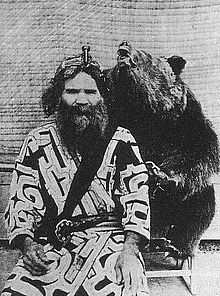
Japanese society, with its ideology of homogeneity, has traditionally
rejected any need to recognize ethnic differences in Japan, even as
such claims have been rejected by such ethnic minorities as the
Ainu and
Ryukyuan people.
[108] In 2005, former Japanese Prime Minister and current Japanese Deputy Prime Minister
Taro Aso described Japan as a "one civilization, one language, one culture and one race" nation.
[109] However, there are "International Society" NPOs funded by local governments throughout Japan.
[110]
According to
Harvard University professor
Theodore Bestor,
Japan does look very homogeneous from a distant perspective, but in
fact there are a number of very significant minority groups – ethnically
different minority groups – in Japan today, such as the already
mentioned
Ainu and
Ryukyuan people.
[111]
Kazakhstan
Kazakhstan
is among the most multicultural countries in Eurasia, with sizeable
populations of ethnic Kazakhs, Russians, Uzbeks, Ukrainians, Uighurs,
Tatars, Germans and more.
[112]
Kazakhstan is one of a few countries in post-Soviet territories that
managed to avoid interethnic clashes and conflicts in the period of
USSR’s final crisis and its eventual breakup.
[113] In 1995, Kazakhstan created the
Assembly of People of Kazakhstan, an advisory body designed to represent the country's ethnic minorities.
[114]
Malaysia
Malaysia is a multiethnic country, with
Malays making up the majority, close to 58% of the population. About 25% of the population are
Malaysians of Chinese descent.
Malaysians of Indian descent comprise about 7% of the population. The remaining 10% comprises:
- Native East Malaysians, namely Bajau, Bruneian, Bidayuh, Dusun, Iban, Kadazan, Kedayan, Melanau, Orang Ulu, Sarawakian Malays, etc.
- Other native tribes of Peninsular Malaysia, such as the Orang Asli and Siamese people, and
- Non-native tribes of Peninsular Malaysia such as the Chettiars, the Peranakan and the Portuguese.
The
Malaysian New Economic Policy or NEP serves as a form of racial equalization.
[115]
It promotes structural changes in various aspects of life from
education to economic to social integration. Established after the
13 May racial riots of 1969, it sought to address the significant imbalance in the economic sphere where the minority
Chinese population had substantial control over commercial activity in the country.
The
Malay Peninsula has a long history of international trade contacts, influencing its ethnic and religious composition. Predominantly
Malays
before the 18th century, the ethnic composition changed dramatically
when the British introduced new industries, and imported Chinese and
Indian labor. Several regions in the then
British Malaya such as
Penang,
Malacca and
Singapore
became Chinese dominated. Until the riots 1969, co-existence between
the three ethnicities (and other minor groups) was largely peaceful,
although the three main racial groups for the most part lived in
separate communities – the Malays in the villages, the Chinese in the
urban areas, and the Indians in the towns and plantation. More Malays
however have moved into the cities since the 1970s, and the proportion
of the non-Malays have been decreasing continually, especially the
Chinese, due in large part to lower birth-rate and emigration as a
result of
institutionalized discrimination.
[116]
Preceding independence of the
Federation of Malaya, a
social contract was negotiated as the basis of a new society. The contract as reflected in the
1957 Malayan Constitution and the 1963 Malaysian Constitution
states that the immigrant groups are granted citizenship, and Malays'
special rights are guaranteed. This is often referred to the
Bumiputra policy.
These
pluralist
policies have come under pressure from racialist Malay parties, who
oppose perceived subversion of Malay rights. The issue is sometimes
related to the controversial
status of religious freedom in Malaysia.
Philippines
The
Philippines ranks 8th among 240 countries in terms of ethnic diversity.
[117] Among its several
ethnic groups, the country has 10 major distinct groups, mainly the
Visayans,
Tagalogs,
Ilocanos,
Bicolanos,
Moros,
Kapampangans,
Pangasinans,
Sambals and
Ibanags. The Philippines also has several
aboriginal stocks such as the
Aetas,
Igorots,
Lumads,
Mangyans and the
Sama-Bajau. The country also has huge
Spanish and
Chinese communities, as well as a substantial number of
American,
Korean,
Japanese and
Indian communities.
[118] The Philippine government has various programs supporting and preserving the nation's ethnic diversity.
Although there had been no ethnic-based incidents of
armed conflict between many
Christian and
animist groups, the same cannot be said about relations between them on one hand and their
Muslim compatriots on the other. The enduring
war in Muslim Mindanao
is one of the most prominent examples of religious conflicts pestering
the economically frail southwestern Philippines. Since the 1899
Moro Rebellion, Muslim groups across
Mindanao have bolstered armed offensives against
foreign colonizers due to aspirations of
self-determination. However, these efforts have failed resulting to the annexation of the
Islamic regions, particularly the
Sultanate of Sulu to the Philippines.
Singapore
Because of immigration,
Singapore has a Chinese majority population with significant minority populations of
Malays and Indians (predominantly
Tamils). Other prominent smaller groups include
Peranakans and
Eurasians. Besides
English, Singapore recognizes three other languages –
Malay,
Mandarin Chinese and
Tamil.
English was established as the medium of instruction in schools during
the 1960s and 1970s and is the language of trade and government while
the other three languages are taught as second languages ("mother
tongues"). Besides being a
multilingual country, Singapore also acknowledges festivals celebrated by the three main ethnic communities.
During British colonial rule, ethnic enclaves such as
Geylang,
Chinatown, and
Little India were enforced. Presently
(2010),
remnants of colonial ethnic concentration still exist but housing in
Singapore is governed by the Ethnic Integration Policy, which ensures an
even ethnic distribution throughout Singapore.
[119] A similar policy exists in politics as all
Group Representation Constituencies are required to field at least one candidate from an ethnic minority.
South Korea
South Korea remains a relatively homogenous country ethnically, linguistically, and culturally.
[120] Foreigners, expatriates, and immigrants are often rejected by the mainstream South Korean society and face discrimination.
[121]
However, the word "multiculturalism" is increasingly heard in South
Korea. In 2007, Han Geon-Soo, Professor of Cultural Anthropology at
Kangwon National University,
published an article entitled "Multicultural Korea: Celebration or
Challenge of Multiethnic Shift in Contemporary Korea?", noting: "As the
increase of foreign migrants in [South] Korea transforms a single-ethnic
homogeneous [South] Korean society into multiethnic and multicultural
one, [the South] Korean government and the civil society pay close
attention to multiculturalism as an alternative value to their policy
and social movement." He argued, however, that "the current discourses
and concerns on multiculturalism in [South] Korea" lacked "the
constructive and analytical concepts for transforming a society".
[122]
The same year, Stephen Castles of the International Migration Institute argued:
- "Korea no longer has to decide whether it wants to become a
multicultural society. It made that decision years ago – perhaps
unconsciously – when it decided to be a full participant in the emerging
global economy. It confirmed that decision when it decided to actively
recruit foreign migrants to meet the economic and demographic needs of a
fast-growing society. Korea is faced by a different decision today:
what type of multicultural society does it want to be?"[123]
The
Korea Times suggested in 2009 that South Korea was likely to become a multicultural society.
[124] In 2010, an opinion editorial written by Peter Underwood for the
JoongAng Ilbo
stated: "Media in [South] Korea is abuzz with the new era of
multiculturalism. With more than one million foreigners in [South]
Korea, 2 percent of the population comes from other cultures." He
further opined:
- "If you stay too long, Koreans become uncomfortable with you. [...]
Having a 2 percent foreign population unquestionably causes ripples, but
having one million temporary foreign residents does not make Korea a
multicultural society. [...] In many ways, this homogeneity is one of
Korea’s greatest strengths. Shared values create harmony. Sacrifice for
the nation is a given. Difficult and painful political and economic
initiatives are endured without discussion or debate. It is easy to
anticipate the needs and behavior of others. It is the cornerstone that
has helped Korea survive adversity. But there is a downside, too. [...]
Koreans are immersed in their culture and are thus blind to its
characteristics and quirks. Examples of group think are everywhere.
Because Koreans share values and views, they support decisions even when
they are obviously bad. Multiculturalism will introduce contrasting
views and challenge existing assumptions. While it will undermine the
homogeneity, it will enrich Koreans with a better understanding of
themselves."[125]
Although many debates still take place as to whether South Korea
really is a multicultural society or not, it is generally agreed
[by whom?]
that South Korea has probably entered a stage of multiculturalism and
has moved away from its homogeneous identity. Around 35–40% of South
Korean men in the rural area outside Seoul are engaged with wives from
different countries.
[citation needed] According to the
Dongponews,
an online media that connects migrants and immigrants of South Korea,
the number of foreigners residing in South Korea reached 1.43 million by
2012, and is likely to increase more and more, reaching to the scale
that cannot be undermined. More than that, South Korea is going through a
serious stage of low birthrate, leading to an aging society in shortage
of labor forces. Another big changing factor is that Korea already has
multi-ethnic, multi-cultural families appearing in great numbers, as one
in every ten marriage is between a South Korean and a foreigner, and in
the rural side this portion is greater.
[126]
As such change takes place in such short period of time, it can be
understood that many conflicts arise among different groups of people;
the immigrants, government, and the rest of Korean society. Recently
[when?]
a lot of media attention is given to these people; documentaries on the
lives of wives and their children are often shown, as well as talk
shows that portray struggles and conflicts these people go through such
as Love in Asia; a talk show hosting foreign wives, sharing their
experience of marriage and family life, broadcast by the national
broadcasting channel, KBS. Many South Koreans recently have recognized
that the change that South Korean society is going through due to this
media attention. Government policies have also changed very recently; a
lot of welfare programs and extracurricular activities are launched
under the name of "multicultural policy." The policy is quite recent
phenomenon.
[citation needed]
United Arab Emirates
Although
Arabic is the official language of the
United Arab Emirates,
English,
Malayalam,
Hindi,
Urdu,
Tagalog,
Bengali,
Indonesian,
Persian and many other languages are widely spoken and understood, particularly in the main cities of
Dubai and
Abu Dhabi. The
UAE hosts expatriate workers from 200 countries, with a majority coming from the
Indian subcontinent.
The UAE has widely accepted all other religions, granting permission
for the construction of temples or churches. Foreigners make up about
85% of the population. However, the UAE does not have an open
immigration policy and Emirati citizens form a largely homogeneous Arab
society; all foreigners reside in the country as temporary workers and
visitors.
Americas
Argentina

Though not called
Multiculturalism as such, the
preamble of Argentina's constitution explicitly promotes
immigration, and recognizes the individual's
multiple citizenship from other countries. Though 97% of Argentina's population self-identify as of
European descent[127][128] to this day a high level of multiculturalism remains a feature of
Argentina's culture,
[129][130] allowing foreign festivals and holidays (e.g.
Saint Patrick's Day), supporting all kinds of art or cultural expression from
ethnic groups,
as well as their diffusion through an important multicultural presence
in the media; for instance it is not uncommon to find newspapers
[131] or radio programs in
English,
German,
Italian,
French or
Portuguese in Argentina.
Canada

Canadian society is often depicted as being "very progressive, diverse, and multicultural".
[132] Multiculturalism (a
Just Society[133]) was adopted as the official policy of the
Canadian government during the premiership of
Pierre Elliott Trudeau in the 1970s and 1980s.
[134] Multiculturalism is reflected in the law through the
Canadian Multiculturalism Act[135] and
section 27 of the Canadian Charter of Rights and Freedoms.
[136] The
Broadcasting Act of 1991 asserts the Canadian broadcasting system should reflect the diversity of cultures in the country.
[137][138]
Canadian multiculturalism is looked upon with admiration outside the
country, resulting in the Canadian public dismissing most critics of the
concept.
[139][140] Multiculturalism in Canada is often looked at as one of Canada's significant accomplishments,
[141] and a key distinguishing element of
Canadian identity.
[142][143]
In a 2002 interview with the
Globe and Mail,
Karīm al-Hussainī the 49th
Aga Khan of the
Ismaili Muslims described Canada as "the most successful
pluralist society on the face of our globe", citing it as "a model for the world".
[144]
He explained that the experience of Canadian governance – its
commitment to pluralism and its support for the rich multicultural
diversity of its peoples – is something that must be shared and would be
of benefit to all societies in other parts of the world.
[144]
The Economist ran a cover story in 2016 praising Canada as the most successful multicultural society in the West.
[145] The Economist
argued that Canada's multiculturalism was a source of strength that
united the diverse population and by attracting immigrants from around
the world was also an engine of economic growth as well.
[145]
Mexico
Mexico
has historically always been a multicultural country, with people of
ethnic groups including those of indigenous background, various European
backgrounds, Africans, and a small Asian community.
[146] Mexico City
has recently been integrating rapidly, doing much better than many
cities in a sample conducted by the Intercultural Cities Index (being
the only non-European city, alongside
Montreal, on the index).
[147]
United States

In the United States, multiculturalism is not clearly established in
policy at the federal level, but ethnic diversity is common in both
rural and urban areas.
Continuous mass immigration was a feature of the United States economy and society since the first half of the 19th century.
[148] The absorption of the stream of immigrants became, in itself, a prominent feature of America's
national myth. The idea of the
melting pot is a
metaphor that implies that all the immigrant cultures are mixed and amalgamated without state intervention.
[149]
The melting pot theory implied that each individual immigrant, and each
group of immigrants, assimilated into American society at their own
pace. This is different than multiculturalism as defined above, which
does not include complete assimilation and integration.
[150] An Americanized (and often stereotypical) version of the original nation's cuisine, and its holidays, survived.
[citation needed] The melting pot tradition co-exists with a belief in national unity, dating from the
American founding fathers:
Providence has been pleased to give this one connected country to one
united people – a people descended from the same ancestors, speaking
the same language, professing the same religion, attached to the same
principles of government, very similar in their manners and customs...
This country and this people seem to have been made for each other, and
it appears as if it was the design of Providence, that an inheritance so
proper and convenient for a band of brethren, united to each other by
the strongest ties, should never be split into a number of unsocial,
jealous, and alien sovereignties.[151]
Staff of President Clinton's
One America Initiative.
The President's Initiative on Race was a critical element in President
Clinton's effort to prepare the country to embrace diversity.
As a
philosophy, multiculturalism began as part of the
pragmatism movement at the end of the nineteenth century in
Europe and the United States, then as
political and
cultural pluralism at the turn of the twentieth.
[152]
It was partly in response to a new wave of European imperialism in
sub-Saharan Africa and the massive immigration of Southern and Eastern
Europeans to the United States and
Latin America. Philosophers, psychologists and historians and early sociologists such as
Charles Sanders Peirce,
William James,
George Santayana,
Horace Kallen,
John Dewey,
W. E. B. Du Bois and
Alain Locke developed concepts of cultural pluralism, from which emerged what we understand today as multiculturalism. In
Pluralistic Universe (1909), William James espoused the idea of a "
plural society." James saw pluralism as "crucial to the formation of philosophical and social
humanism to help build a better, more egalitarian society.
[153]
The educational approach to multiculturalism has since spread to the
grade school
system, as school systems try to rework their curricula to introduce
students to diversity earlier – often on the grounds that it is
important for minority students to see themselves represented in the
classroom.
[154][155] Studies estimated 46 million Americans ages 14 to 24 to be the most diverse generation in American society.
[156]
In 2009 and 2010, controversy erupted in Texas as the state's
curriculum committee made several changes to the state's requirements,
often at the expense of minorities. They chose to juxtapose
Abraham Lincoln's inaugural address with that of Confederate president
Jefferson Davis;
[157] they debated removing Supreme Court Justice
Thurgood Marshall and labor-leader
Cesar Chavez[158] and rejected calls to include more Hispanic figures, in spite of the high Hispanic population in the state.
[159]
Support
Multiculturalism is seen by its supporters as a fairer system that
allows people to truly express who they are within a society, that is
more tolerant and that adapts better to social issues.
[164]
They argue that culture is not one definable thing based on one race or
religion, but rather the result of multiple factors that change as the
world changes.
Historically, support for modern multiculturalism stems from the
changes in Western societies after World War II, in what Susanne
Wessendorf calls the "human rights revolution", in which the horrors of
institutionalized racism and
ethnic cleansing became almost impossible to ignore in the wake of the
Holocaust; with the collapse of the
European colonial system, as colonized nations in Africa and
Asia successfully
fought for their independence
and pointed out the discriminatory underpinnings of the colonial
system; and, in the United States in particular, with the rise of the
Civil Rights Movement, which criticized ideals of
assimilation
that often led to prejudices against those who did not act according to
Anglo-American standards and which led to the development of academic
ethnic studies programs as a way to counteract the neglect of contributions by racial minorities in classrooms.
[165][166]
As this history shows, multiculturalism in Western countries was seen
to combat racism, to protect minority communities of all types, and to
undo policies that had prevented minorities from having full access to
the opportunities for freedom and equality promised by the
liberalism that has been the hallmark of Western societies since the
Age of Enlightenment. The
contact hypothesis
in sociology is a well documented phenomenon in which cooperative
interactions with those from a different group than one's own reduce
prejudice and inter-group hostility.
C. James Trotman argues that multiculturalism is valuable because it
"uses several disciplines to highlight neglected aspects of our social
history, particularly the histories of women and minorities [...and]
promotes respect for the dignity of the lives and voices of the
forgotten.
[167] By closing gaps, by raising consciousness about the past, multiculturalism tries to restore a sense of wholeness in a
postmodern era that fragments human life and thought."
[167]
Tariq Modood
argues that in the early years of the 21st century, multiculturalism
"is most timely and necessary, and [...] we need more not less", since
it is "the form of integration" that (1) best fits the ideal of
egalitarianism, (2) has "the best chance of succeeding" in the "post-
9/11, post
7/7" world, and (3) has remained "moderate [and] pragmatic".
[168]
Bhikhu Parekh
counters what he sees as the tendencies to equate multiculturalism with
racial minorities "demanding special rights" and to see it as promoting
a "thinly veiled racis[m]". Instead, he argues that multiculturalism is
in fact "not about minorities" but "is about the proper terms of
relationship between different cultural communities", which means that
the standards by which the communities resolve their differences, e.g.,
"the principles of justice" must not come from only one of the cultures
but must come "through an open and equal dialogue between them."
[169]
Balibar characterizes criticisms of multiculturalism as
"differentialist racism", which he describes as a covert form of racism
that does not purport ethnic superiority as much as it asserts
stereotypes of perceived "incompatibility of life-styles and
traditions".
[170]
While there is research that suggests that ethnic diversity increases
chances of war, lower public goods provision and decreases
democratization, there is also research that shows that ethnic diversity
in itself is not detrimental to peace,
[171][172] public goods provision
[173][174] or democracy.
[175] Rather, it was found that promoting diversity actually helps in advancing disadvantaged students.
[176]
The
Wikimedia Foundation
suggests that "diversity of perspectives is crucial to increasing the
quality of the free knowledge resources that [their] movement provides".
[177] Wikidata
also suggests that "the world is complicated and there is no single
truth–especially in a knowledge base that is supposed to serve many
cultures."
[178]
Criticism
Critics of multiculturalism often debate whether the multicultural
ideal of benignly co-existing cultures that interrelate and influence
one another, and yet remain distinct, is sustainable, paradoxical, or
even desirable.
[179][180][181] It is argued that
nation states,
who would previously have been synonymous with a distinctive cultural
identity of their own, lose out to enforced multiculturalism and that
this ultimately erodes the host nations' distinct culture.
[182]
Harvard professor of political science
Robert D. Putnam conducted a nearly decade-long study on how multiculturalism affects social trust.
[183]
He surveyed 26,200 people in 40 American communities, finding that when
the data were adjusted for class, income and other factors, the more
racially diverse a community is, the greater the loss of trust. People
in diverse communities "don’t trust the local mayor, they don’t trust
the local paper, they don’t trust other people and they don’t trust
institutions," writes Putnam.
[184] In the presence of such ethnic diversity, Putnam maintains that:
"[W]e hunker down. We act like turtles. The effect of diversity is
worse than had been imagined. And it’s not just that we don’t trust
people who are not like us. In diverse communities, we don’t trust
people who do look like us".[183]
Putnam has also stated, however, that "this allergy to diversity
tends to diminish and to go away... I think in the long run we'll all be
better."
[185]
Ethnologist Frank Salter writes:
Relatively homogeneous societies invest more in public goods,
indicating a higher level of public altruism. For example, the degree of
ethnic homogeneity correlates with the government's share of gross
domestic product as well as the average wealth of citizens. Case studies
of the United States, Africa and South-East Asia find that multi-ethnic
societies are less charitable and less able to cooperate to develop
public infrastructure. Moscow beggars receive more gifts from fellow
ethnics than from other ethnies [sic].
A recent multi-city study of municipal spending on public goods in the
United States found that ethnically or racially diverse cities spend a
smaller portion of their budgets and less per capita on public services
than do the more homogeneous cities.[186]
Dick Lamm, former three-term Democratic governor of the US state of
Colorado, wrote in his essay "I have a plan to destroy America":
Diverse peoples worldwide are mostly engaged in hating each
other—that is, when they are not killing each other. A diverse,
peaceful, or stable society is against most historical precedent."[187]
A number of conservative historians used the religion of the Mexica,
better known as the Aztecs as an example of what they see as the flaws
of multiculturalism. The Australian historian
Keith Windschuttle cited the accounts of his fellow Australian historian
Inga Clendinnen of the festival of
Ochpaniztli where to honor the Maize Lord a young woman was sacrificed by ripping out her heart so the crops might grow:
Then, still in darkness, silence, and urgent haste, her body was
flayed, and a naked priest, a 'very strong man, very powerful, very
tall', struggled into the wet skin, with its slack breasts and pouched
genitalia: a double nakedness of layered, ambiguous sexuality. The skin
of one thigh was reserved to be fashioned into a face-mask for the man
impersonating Centeotl, Young Lord Maize Cob, the son of Toci.[188]
Windschuttle argued that the gruesome religion of the Aztecs that
required that dozens of young people be sacrificed and eaten every day
so that the sun might rise the next day and hundreds of people
sacrificed for major holidays as proving that multiculturalism is a
facile doctrine that requires Westerners to respect Aztec religion as
equal to any other religion.
[189] The American classicist
Victor Davis Hanson
used the perceived differences in "rationality" between Moctezuma and
Cortés to argue that Western culture was superior to every culture in
the entire world, which thus led him to reject multiculturalism as a
false doctrine that placed all cultures on an equal footing.
[190]
In
New Zealand (
Aotearoa), which is officially bi-cultural, multiculturalism has been seen as a threat to the
Maori, and possibly an attempt by the New Zealand Government to undermine Maori demands for self determination.
[191]


